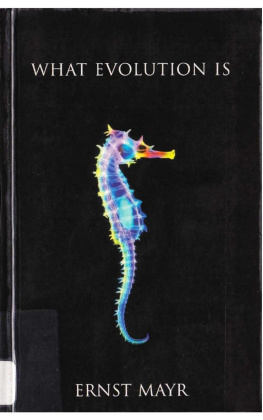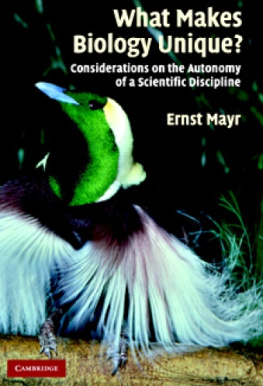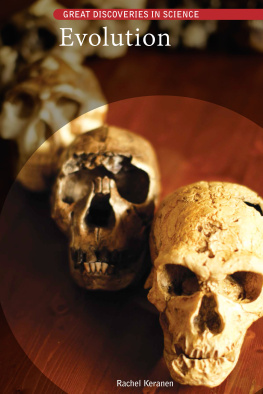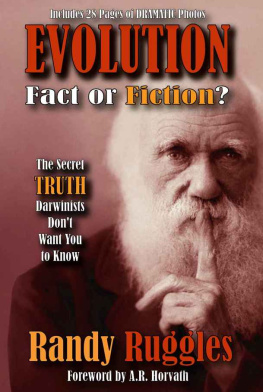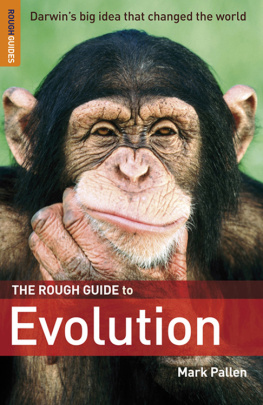
Ernst Mayr was born in Kempten, Germany, in 1904. One
of the main architects of the modern synthesis of genetic
and evolutionary theory, his career has spanned fields as
diverse as ornithology, systematics, zoo-geography, evolu
tionary theory and the philosophy and history of science.
He has written sixteen books, and published more than
seven hundred scientific papers. In 1953 he joined the
Museum of Comparative Zoology at Harvard University,
where he is currently Professor Emeritus.
By Ernst Mayr
T h e Birds of Northern Melanesia (with Jared Diamond)
W h a t Evolution Is
This is Biology
One Long Argument
T h e Principles of Systematic Zoology (with Peter Ashlock)
Toward a New Philosophy of Biology
T h e Growth of Biological Thought
T h e Evolutionary Synthesis (with W. Provine)
Biologie de L'Evolution
Evolution and the Diversity of Life
Populations, Species and Evolution
Animal Species and Evolution
Methods and Principles of Systematic Zoology (with E. G.
Linsley and R. L. Usinger)
Birds of the Philippines (with Jean Delacour)
Birds of the Southwest Pacific
Systematics and the Origin of Species

W H A T E V O L U T I O N I S
Ernst Mayr
PHOENIX
A PHOENIX PAPERBACK
First published in Great Britain in 2002
by Weidenfeld & Nicolson
This paperback edition published in 2002
by Phoenix,
an imprint of Orion Books Ltd,
Orion House, 5 Upper St Martin's Lane,
London W C 2 H 9EA
First published in the USA in 2001
by BasicBooks, a member of the
Perseus Books Group
Copyright Ernst Mayr 2001
T h e right of Ernst Mayr to be identified as the
author of this work has been asserted by him in accordance
with the Copyright, Designs and Patents Act 1988.
All rights reserved. No part of this publication may be
reproduced, stored in a retrieval system, or transmitted,
in any form or by any means, electronic, mechanical,
photocopying, recording or otherwise, without the prior
permission of the copyright owner.
A CIP catalogue record for this book
is available from the British Library.
ISBN 0 75381 368 8
Printed and bound in Great Britain by
Clays Ltd, St Ives pic
C O N T E N T S
Foreword by Jared M. Diamond vii
Preface xiii
Acknowledgments xvii
P A R T I
W H A T I S E V O L U T I O N ?
1 In W h a t Kind of a World Do We Live? 3
2 What Is the Evidence for Evolution on Earth? 13
3 The Rise of the Living World 43
P A R T I I
H O W A R E E V O L U T I O N A R Y C H A N G E A N D
A D A P T E D N E S S E X P L A I N E D ?
4 How and W h y Does Evolution Take Place? 79
5 Variational Evolution 91
6 Natural Selection 127
7 Adaptedness and Natural Selection: Anagenesis 163
P A R T I I I
O R I G I N A N D E V O L U T I O N O F D I V E R S I T Y : C L A D O G E N E S I S
8 The Units of Diversity: Species 177
9 Speciation 192
10 Macroevolution 207
W H A T E V O L U T I O N I S
P A R T I V
H U M A N E V O L U T I O N
11 How Did Mankind Evolve? 257
12 The Frontiers of Evolutionary Biology 293
Appendix A: What Criticisms Have Been Made
of Evolutionary Theory? 297
Appendix B: Short Answers to Frequently Asked Questions
About Evolution 302
Glossary 311
Bibliography 321
Index 331
F O R E W O R D
Evolution is the most profound and powerful idea to have been
conceived in the last two centuries. It was first developed in detail with the 1859 publication of the book On the Origin of Species, by Charles Darwin, who enjoyed a long and incredibly productive
life. While Darwin's professional career began with a round-the
world biological collecting trip on which he embarked at the age of 22 aboard the H M S Beagle, he had already been devoted to outdoor natural history as a boy.
A great deal new has been learned about the workings of evolu
tion since Darwin's day. Wouldn't it be wonderful if Darwin
himself, a clear and forceful writer as well as the greatest biologist of his generation, could write for us a new book on the status of evolutionary thought today! Of course that's impossible, because Darwin died in 1882. This book is the next best: it has been written by a man who is one of the greatest biologists of our own day, who has also enjoyed a long and incredibly productive life, and who is also a clear and forceful writer.
To place Ernst Mayr in perspective, I'll relate an experience of my own. In 1990 I carried out the second bird survey of the
Cyclops Mountains, a steep, high, isolated range rising from the north coast of the tropical island of New Guinea. The survey
proved to be difficult and dangerous, because of the daily risks of falling off the steep slippery trails, of getting lost in the dense jungle, of exposure in cold wet conditions, and of potential conflicts with local people on whom I depended but who had their
own agendas. Fortunately, New Guinea had by then been "pacified" for many years. Local tribes were no longer at war with each other, and European visitors were a familiar sight and were no
longer at risk of being murdered. None of those advantages existed in 1928, when the first bird survey of the Cyclops Mountains was W H A T E V O L U T I O N I S
carried out. I found it hard to imagine how anyone could have survived the difficulties of that first survey of 1928, considering the already-severe difficulties of my second survey in 1990.
That 1928 survey was carried out by the then 2 3-year-old Ernst
Mayr, who had just pulled off the remarkable achievement of com
pleting his Ph.D. thesis in zoology while simultaneously completing his pre-clinical studies at medical school. Like Darwin, Ernst had been passionately devoted to outdoor natural history as a boy, and he had thereby come to the attention of Erwin Stresemann, a famous
ornithologist at Berlin's Zoological Museum. In 1928 Stresemann, together with ornithologists at the American Museum of Natural
History in New York and at Lord Rothschild's Museum near
London, came up with a bold scheme to "clean up" the outstanding remaining ornithological mysteries of New Guinea, by tracking
down all of the perplexing birds of paradise known only from specimens collected by natives and not yet traced to their home grounds by European collectors. Ernst, who had never been outside Europe, was the person selected for this daunting research program.
Ernst's "clean-up" consisted of thorough bird surveys of New Guinea's five most important north coastal mountains, a task
whose difficulties are impossible to conceive today in these days when bird explorers and their field assistants are at least not at acute risk of being ambushed by the natives. Ernst managed to
befriend the local tribes, was officially but incorrectly reported to have been killed by them, survived severe attacks of malaria and dengue and dysentery and other tropical diseases plus a forced
descent down a waterfall and a near-drowning in an overturned
canoe, succeeded in reaching the summits of all five mountains,
and amassed large collections of birds with many new species and subspecies. Despite the thoroughness of his collections, they
proved to contain not a single one of the mysterious "missing"
Next page
